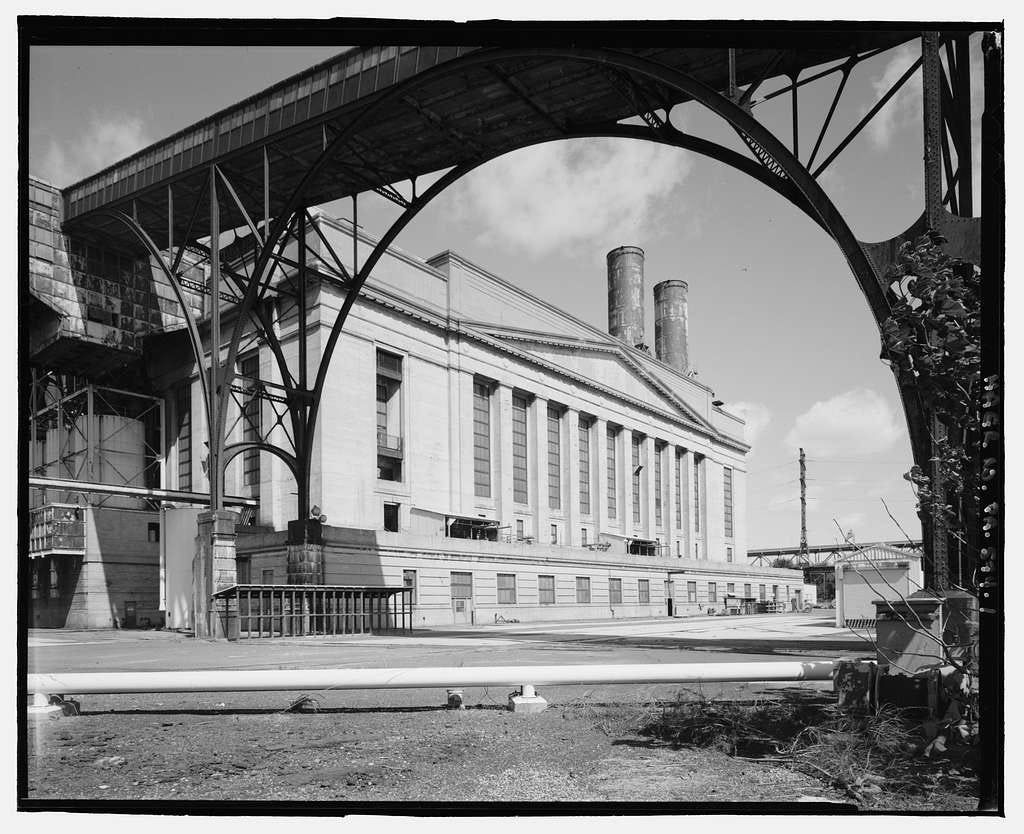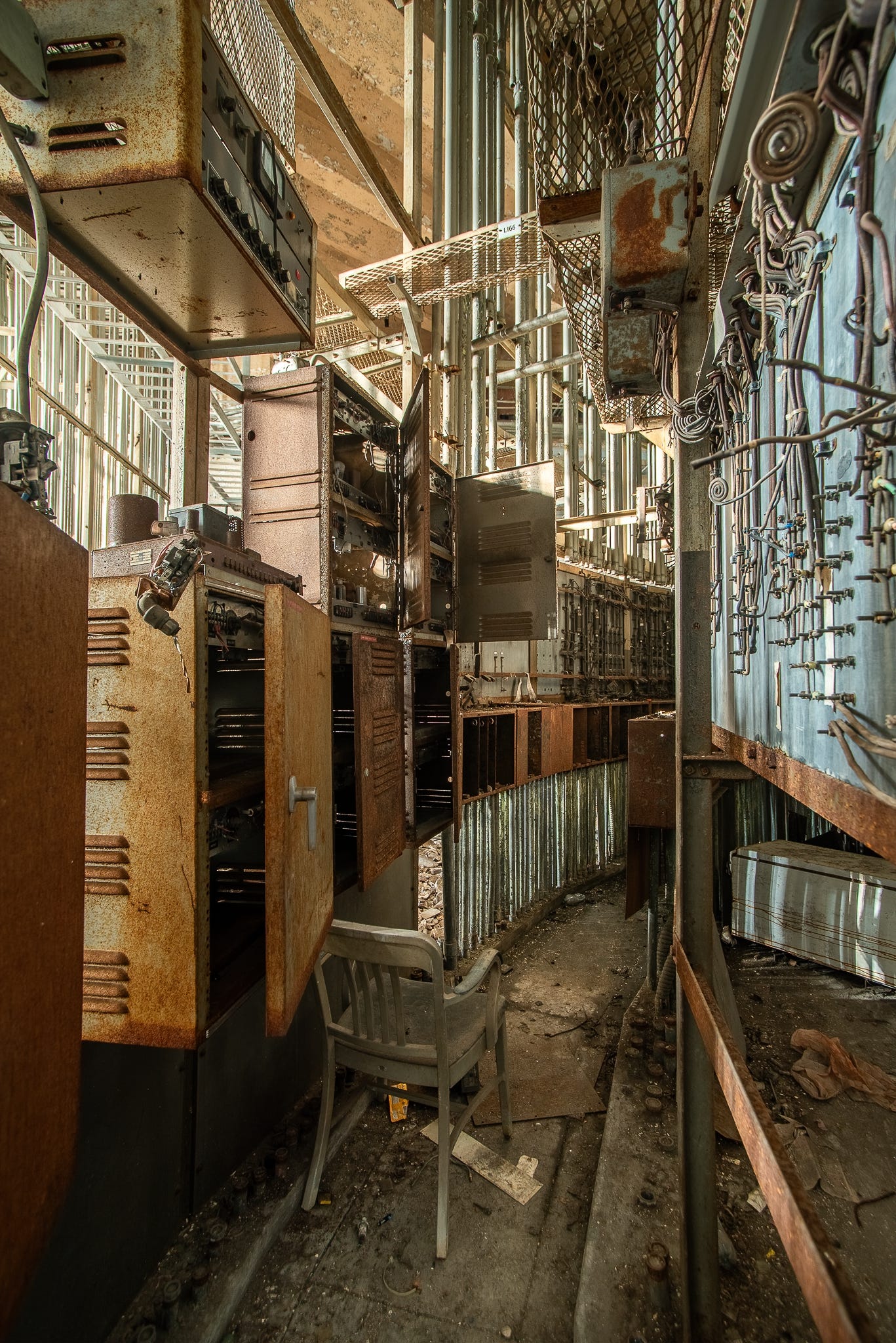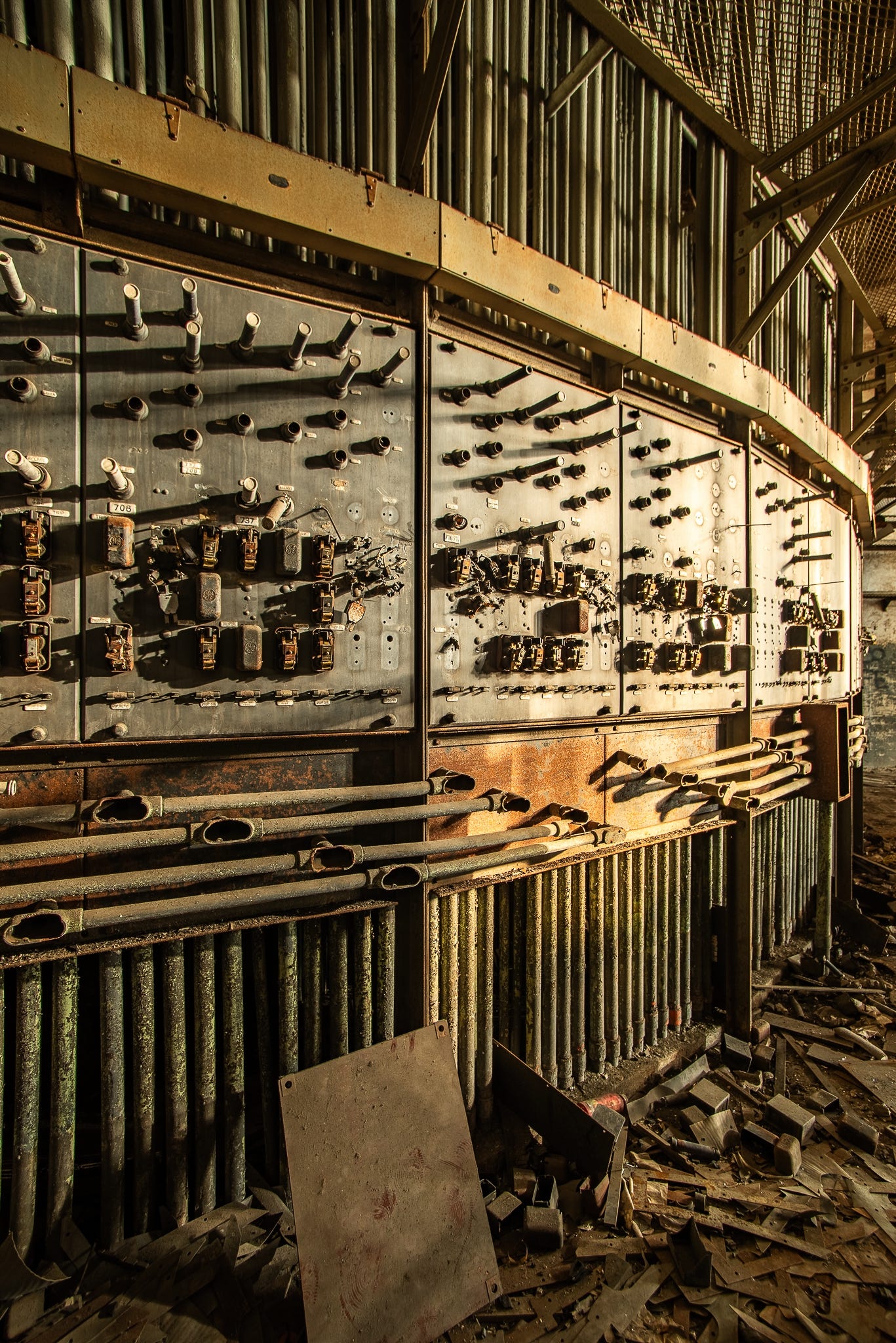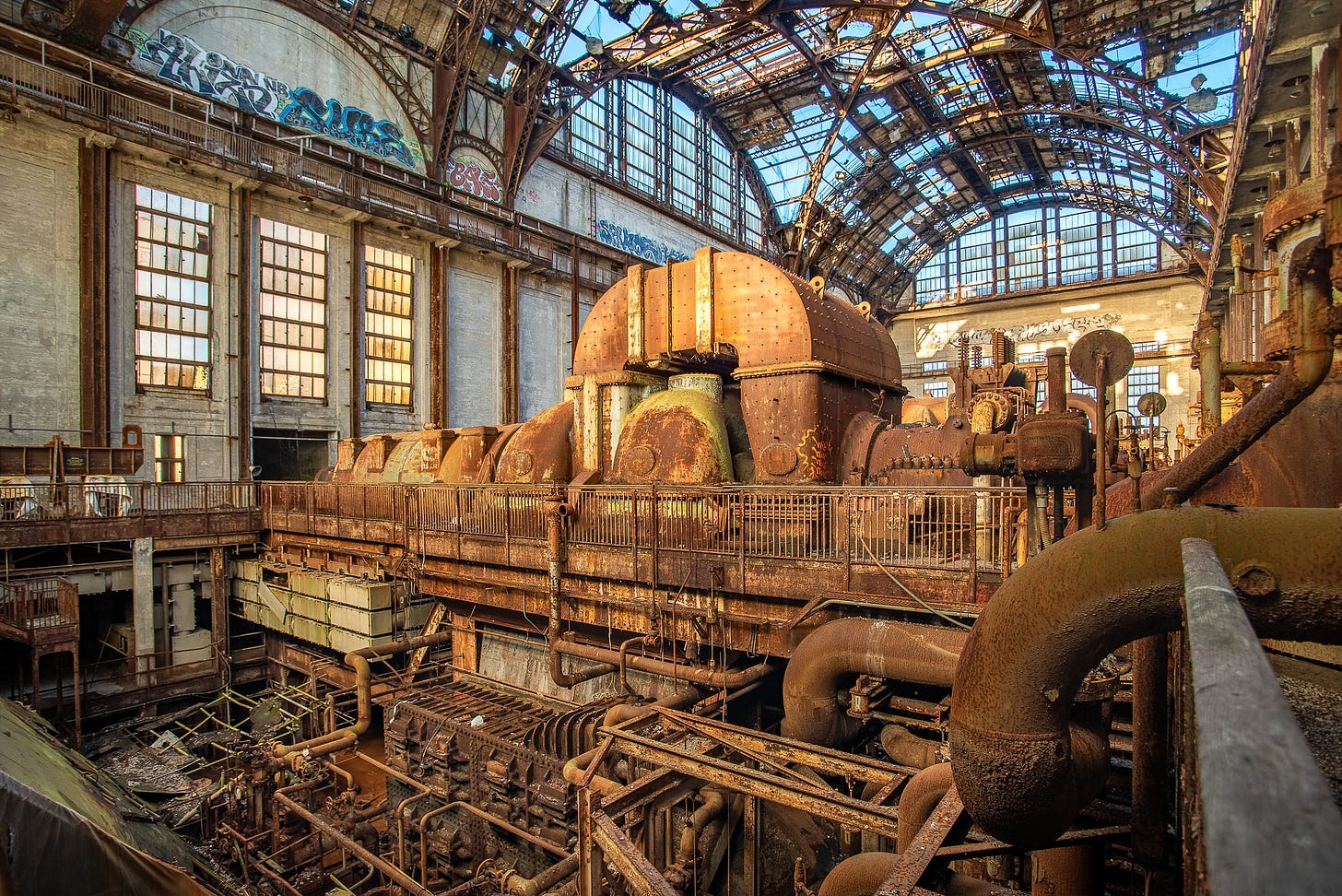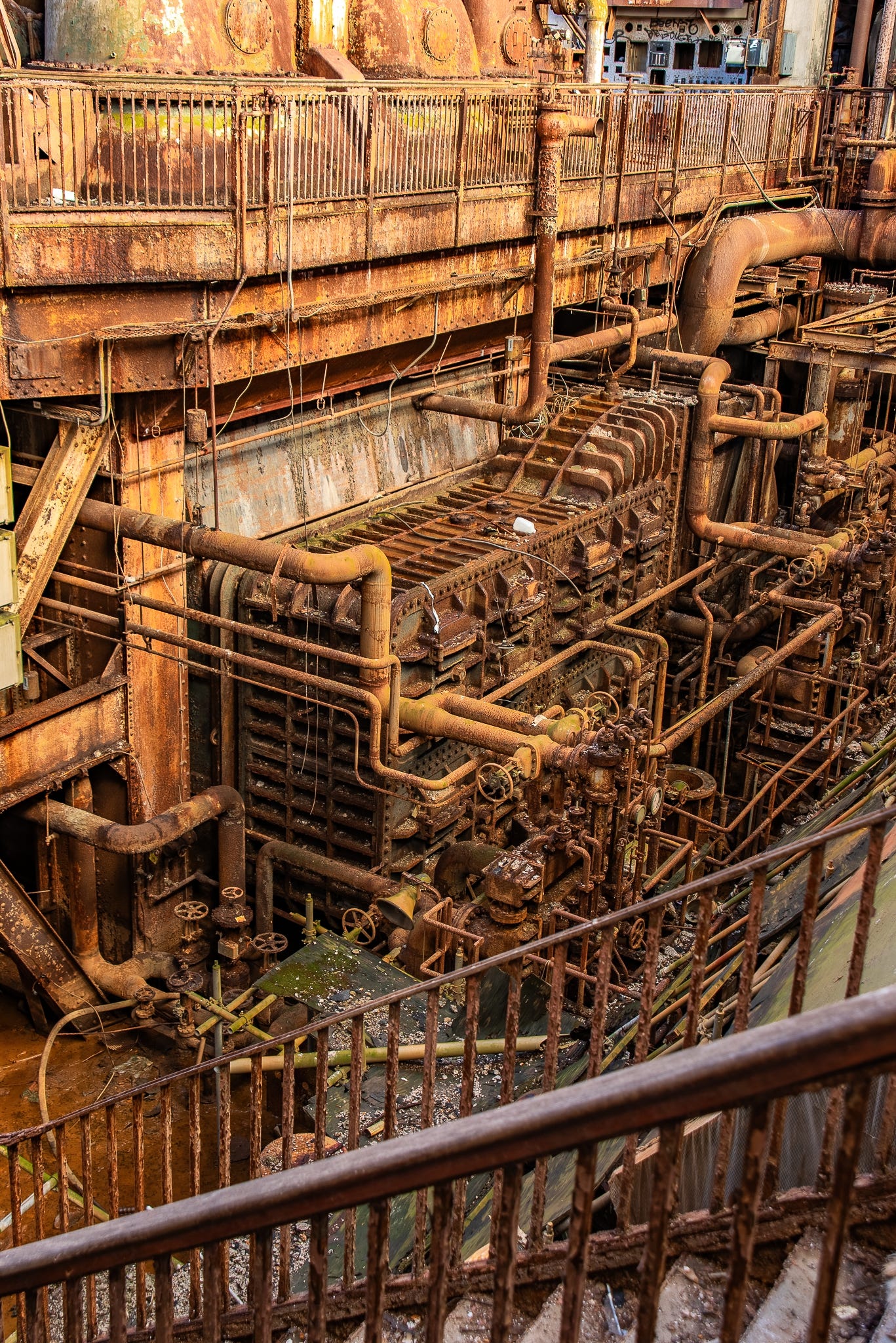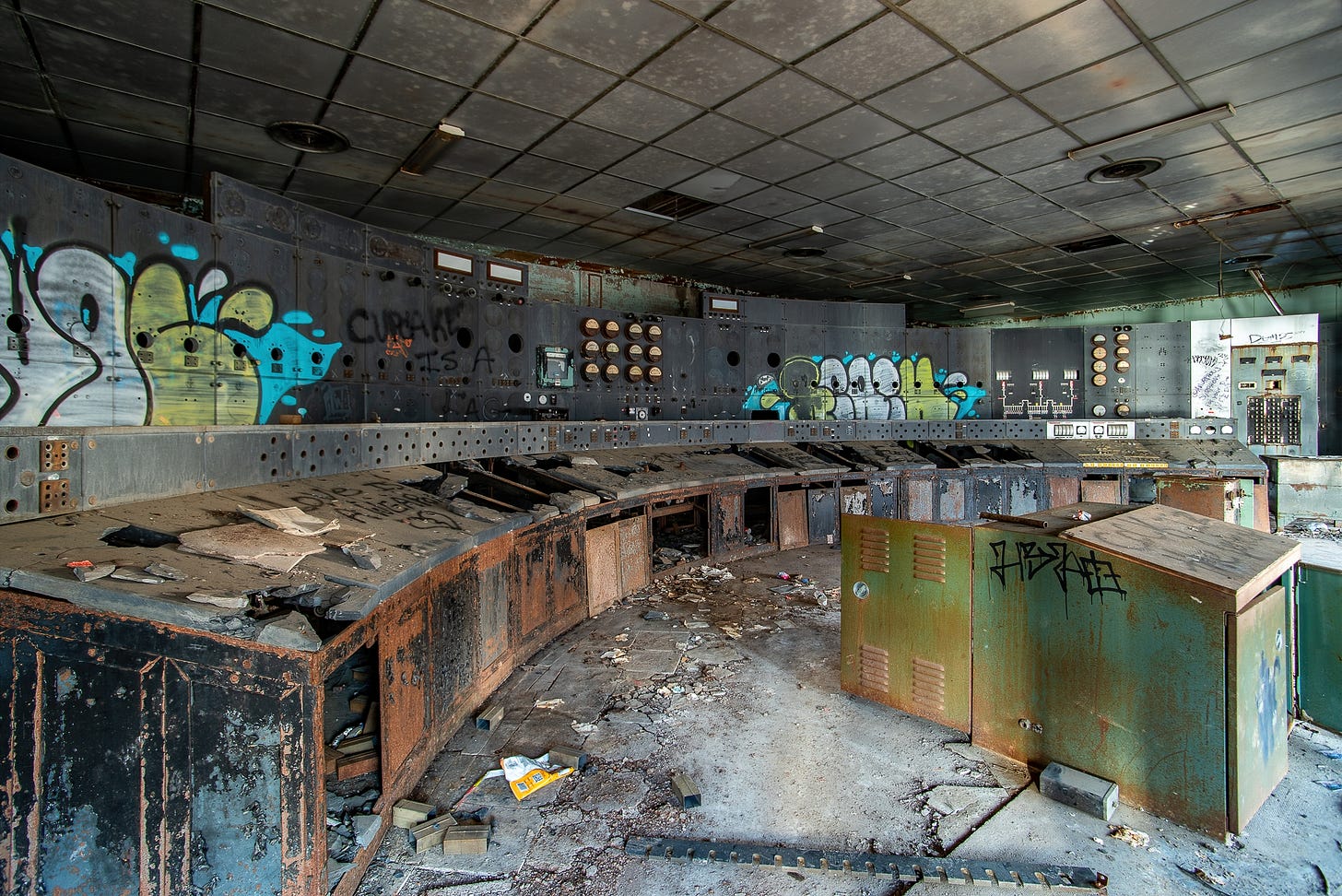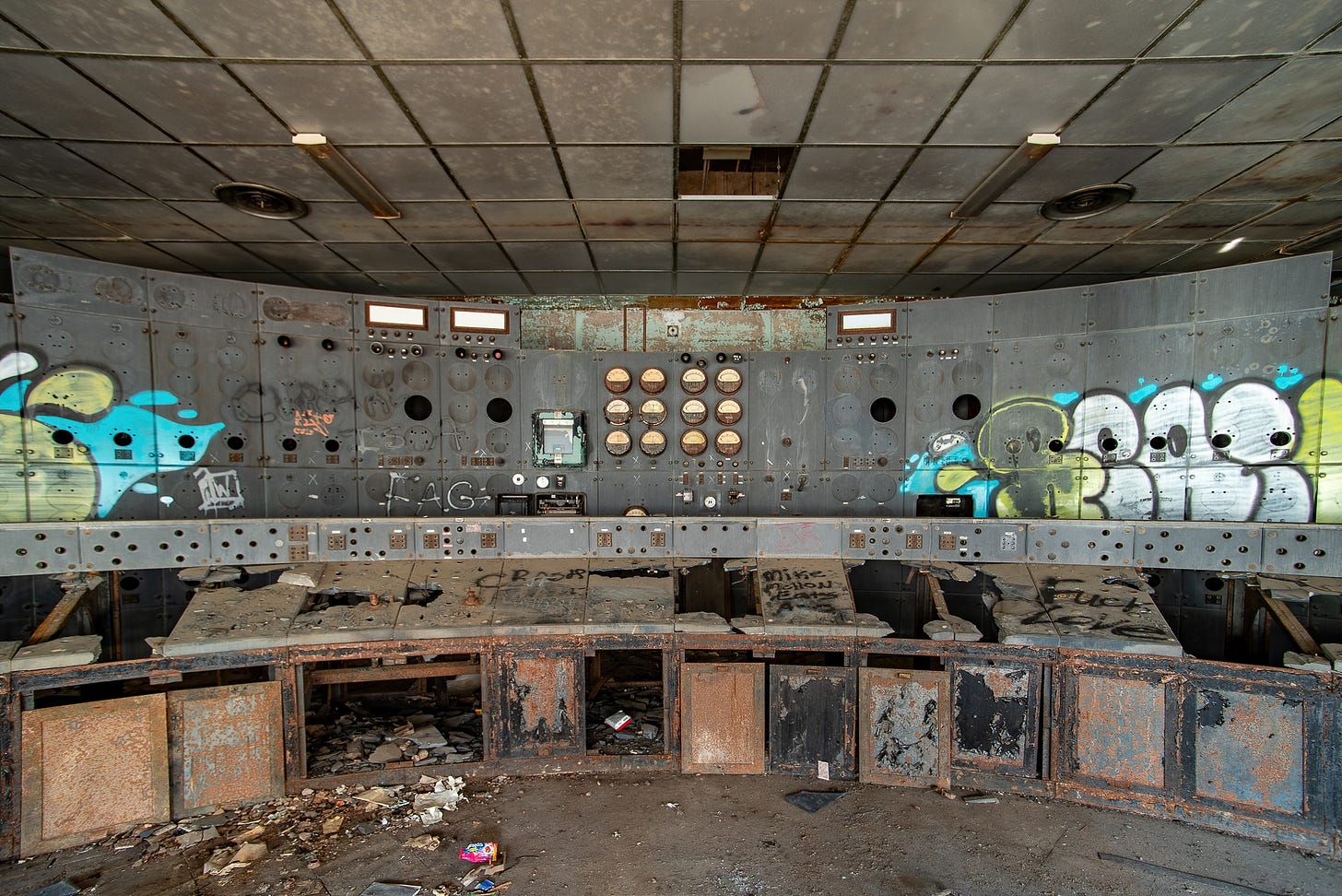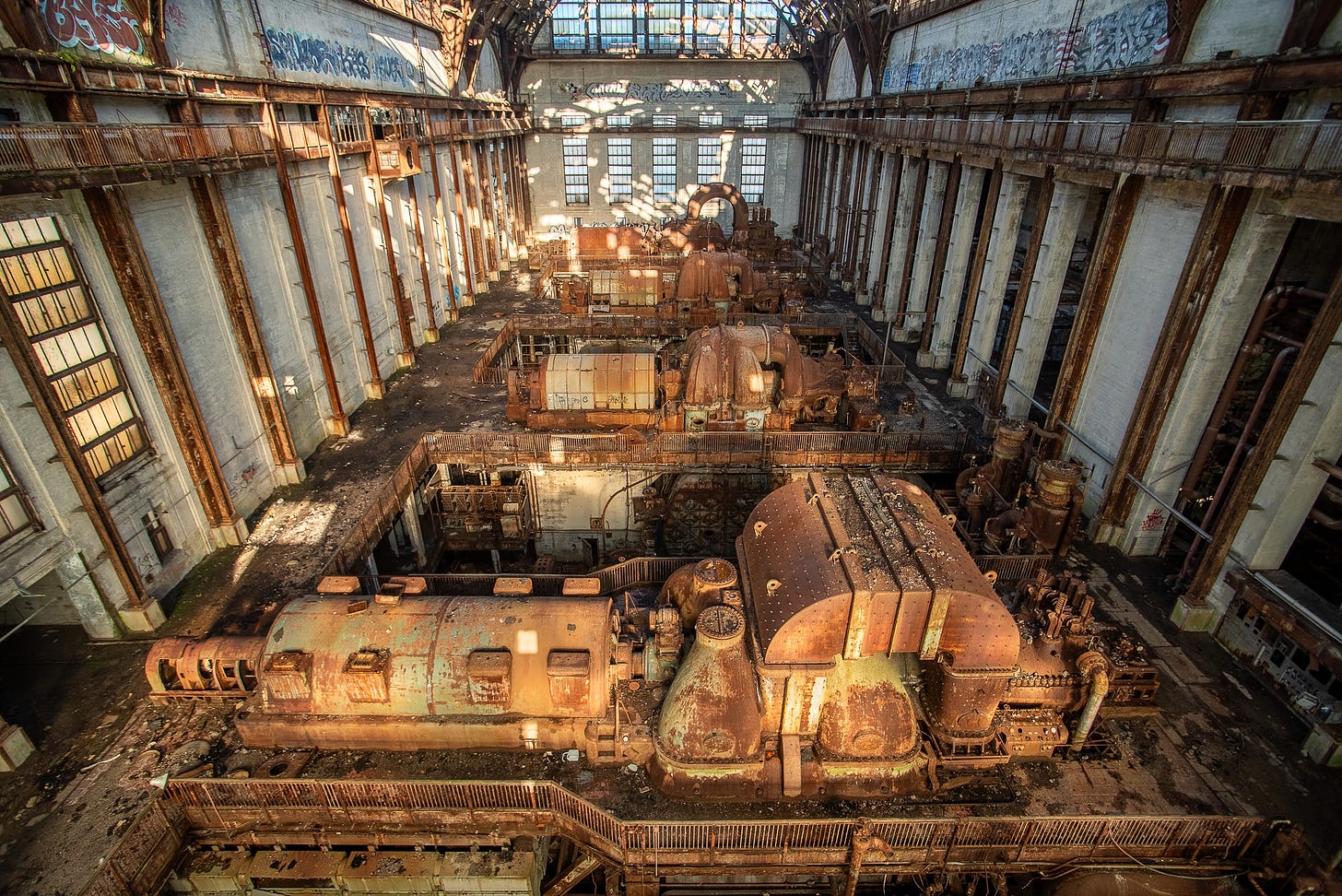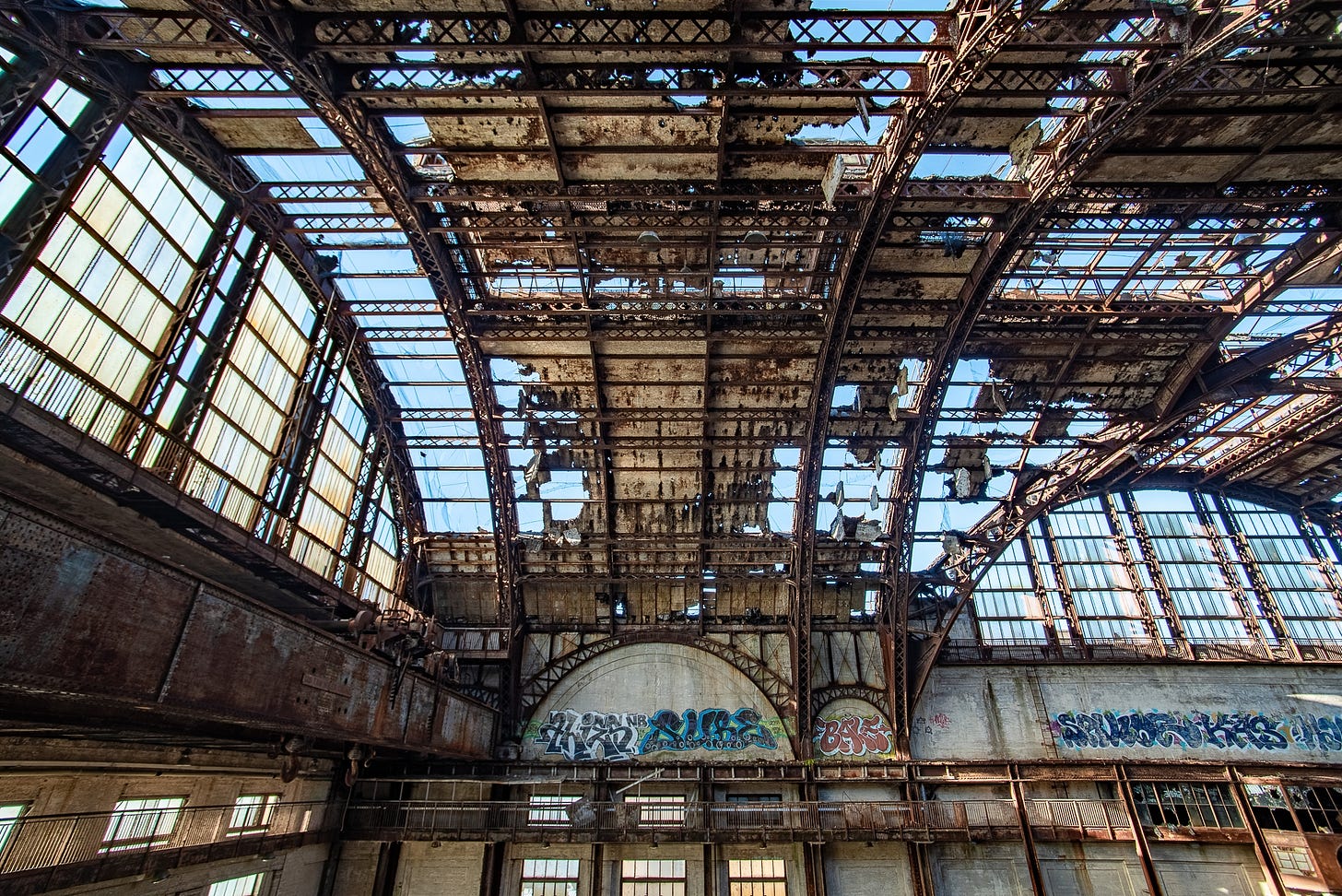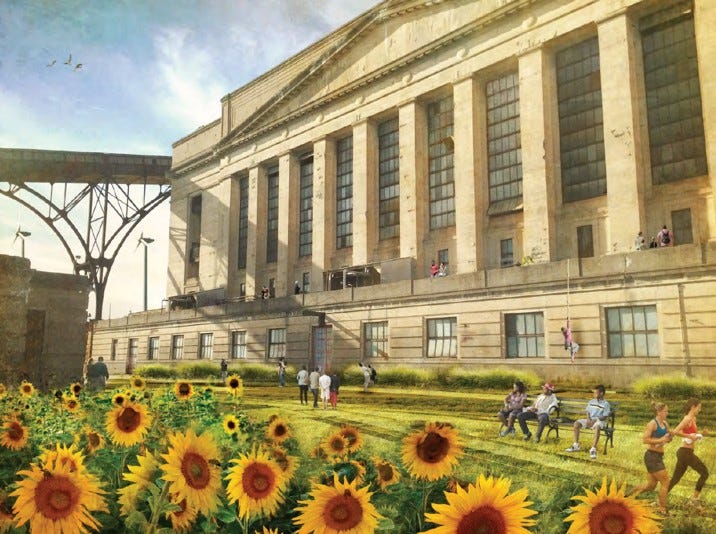Sometimes you make plans to go someplace only to discover that a possibly once in a lifetime opportunity has opened up, and that you might only have a short window of time to take advantage of it. Naturally, you scrap those initial plans and do whatever you need to do to snag the golden ticket if you can. And that is exactly what happened to us about a year ago, on an unseasonably warm weekend in February. When the call came down for this aforementioned opportunity, both myself and one of my good exploring partners swung into action to, in our best Indiana Jones imitation, get to the treasure before it wasn’t there anymore to get. And to get this thing going required not a little planning and a shitload of driving across a long stretch of territory, much of it still encased in Rust Belt lake-effect snow.
Where was this tarnished yet much sought after gem to be located? We found ourselves headed, at the very ass-crack of dawn, for the City of Brotherly Love; Philadelphia, Pennsylvania. On the banks of the Delaware River, stood our target; looming, crumbling and abandoned, but still a wonder of its age, beckoning us to plumb its corroded and defunct industrial depths on that warmish winter day. We were heading for none other than the truly gargantuan Beaux Arts Palace of Shadows and Rust that is the Richmond Generating Station.
Richmond Generating Station: Philadelphia, Pennsylvania (year unknown)
As I mentioned the drive was quite a long haul. That Friday night drive to Buffalo from Cleveland took me at least four hours, slogging up I-90 on the New York Thruway as a mild winter blizzard sashayed down off of Lake Erie, white-knuckling it the entire journey until I stumbled into my hotel room at 11:30 PM and then to bed. Saturday AM, I found myself up at 4 AM to go and meet my Buffalo-based explorer compadre, and from there (after a mandatory stop at Tim Horton’s for breakfast sammiches and caffeine-based drinks), we progressed to make the grueling five and half hour drive to Philly through Central NY and PA. Luckily, the snow had stopped overnight and the NYDOT highway plows had been out in force to clear the way for us as we headed down through the mountains of Central PA. So, all told, a total of almost eight and a half hours one way, and with absolutely NO clue if we’d actually be able to access our eventual target upon arrival. We were making this journey based on the reports of other explorers who had recently been there; as anyone in the business knows, things can change on a dime, and we had no idea on what we’d find when we arrived in town. Word had come down the line that the bucket lister abandoned Richmond Generating Station, a mammoth century-old and decommissioned coal powered plant along the Delaware River had been breached and was now accessible.
Upon arrival, it was obvious that we were definitely not the only ones with the same idea in mind; down the road from the plant, where there was an old and blocked off access road to the back areas of the place and that turn off had become a makeshift parking lot of visiting explorers who, like us, had made the pilgrimage to see the rusty and glorious Titan of industry. Cars from Jersey, PA and New York were lined up along the side of the path and we added our vehicle to their numbers, geared up and began walking down the desolate, trash strewn path that lead to the riverfront, where, according to stories we’d been told, holes in fences would lead the way to our ultimate destination. Here, there was no snow; all of that was left behind as we left New York’s western Lake Erie snow belt. So, one less obstacle to deal with; no footprints would give our presence away to anyone who might seek to keep us from our prize. With the local train transit bridge running to the right of us and the clickety-clack of the occasional commuter rail train blowing by us up on its tracks, and the soaring Betsy Ross Bridge to our left, we dodged mounds of tires, broken household appliances and untold tons of dumped garbage to find our way into the property. It was a dystopian wasteland of entropy, fields of dead grass, stunted trees, trash scattered in piles, the sound of the trains off in the distance and the sound of the waters of the Delaware lapping up against ancient wooden pilings. A place of weird and forgotten slippage the sort of which Philly has in large supply. Edging through several freshly cut holes into the fences that surround the area around the plant, we did some stealth recon of the lot, as we’d been told there might well be some security on site. We DID see a gray minivan parked near to where we needed to be, but we saw no one inside of it. Just to be safe, we made every effort to keep things on the downlow, crossed the lot right in front of van Scooby-Doo tip toe style (something that later we would be amazed we had gotten away with when so many others had not), slipped behind a parked and ragged rusting school bus that was right up against the wall of the plant, and through our entrance. Boom. We were in, with nary a scratch and with no entanglements with local security forces. Our day could finally begin in earnest, as we unpacked the cameras and got down to bid’ness. Naturally, being a temporary dumbass while packing back in Cleveland a day ago, I had forgotten to include my most necessary item for exploring a dangerous and dark power plant; my Fenix flashlight was sitting on my goddamn desk hundreds of miles away in Ohio, exactly where it did NOT need to be. All of that notwithstanding, we found ourselves into the guts of Richmond Generating Plant and into one of the most beautiful and most detailed abandoned Rust Belt works of art I have ever had the pleasure to behold.
The dim innards of the Richmond Generating Station
Before I dive into our fever dream exploits inside this truly gargantuan hulk of a building, let me lay a little history down for you on the life and times of Richmond.
The early 1920s saw a huge population boom in Philly’s northeast side, and that gave rise to the need for an huge increase in Philadelphia Electric's generating capability. Back then, the Schuylkill (pronounced: skoo-kill) and Delaware Generating Stations were the only plants in the city, so the decision to construct a new plant in Richmond was easily made.
As designed, the station was to contain three distinct generating components; each component was to consist of a boiler house to produce steam, a turbine hall, and a switch gear building to control power distribution. Only one of the three generating components was constructed. Turbine Hall was one of the largest open rooms ever designed, modeled after the ancient Roman baths. Two of its four turbo-generator units were installed and twelve of its 24 planned boilers were put into place. The plant operated for ten years in this manner; lack of anticipated power demands plus the construction of the Conowingo Hydroelectric Facility on the Susquehanna River in northeastern Maryland made additional equipment and generating capability unnecessary.
In 1935, a third unit was installed and after World War II, it was overhauled and two new boilers were added; this extra bit of power pushed the generating capability of the unit up to full capacity. In 1951, a fourth unit was added. You can totally see the differences in the units when you look down at the entire facility from upon high. They were all definitely different models built in different time periods.
After years of service, as the need switched over to newer and more modern facilities elsewhere, the steam plant was shut down in 1984, and with the exception of some of its equipment being removed to be used elsewhere, it sits as it was left decades ago.
That’s the short of it; Richmond has quite the checkered past if one dives into it. But for time, let’s get back to the adventuring and rust spelunking at hand.
One of almost countless consoles that once helped regulate Richmond’s massive complex.
Upon entering the plant, we immediately ran into some local explorers, and after the usual, perfunctory exchanging of pleasantries and Instagram accounts, they proceeded to tell us about the live work that was going on in the pits below the main turbine hall. There was a scrapping crew of unknown number down there, noisily draining decades worth of stagnant, rot-stinking and dead-muddy Delaware River water out of the rust-girded depths of the plant, where untold miles of pipes and brown-stained and crusty mechanisms were seeing the light of day for the first time in many a year. They’d been plugging away down there for the entire day, but had had no clue that our comrades in arms had been in the plant above them since sun-up that morning, due to all the insane racket they’d been making with the pumps and the occasional acetylene cutters being used to slice up some of the unknown metal junk in the darkness, in preparation of hoisting some of them out of the depths to be scrapped. As long as we stayed out of sight, they’d never know we were there either. Saying our adieus, my partner and I delved into the dark recesses of Richmond, looking for the elusive stairwell that would take us up and into the heart of the plant, where the turbine hall awaited our anxious camera trigger fingers. Again, I felt like such a total maroon for having to move sluggishly through the grimy water that was, in some places an inch or two deep on the floor, footstep to footstep without the bright assurances of my absent flashlight, patiently awaiting my return back in Cleveland, but rather than step into a hole, break my ankle or worse, slow had to be the way of things until we ascended into the light.
Rusting mechanical systems and pipes inside the generating station…
Eventually, after ten minutes of bouncing aimlessly around through the feeble light of the Stygian, labyrinthine passageways of the ground floor, a ray of light beckoned in the distance; finally, a stairwell into the upper areas. Ascending the jank-as-all-get-out rusting metal stairwell up into the orange light above, we entered out into a vast and majestic Kingdom of Rust and Soaring Elegance; at last, the sight we had traveled hours to witness, the massive turbine hall of the Richmond Generating Plant, in all of its magnificence. I’ve explored several power plants in various states and from different eras, but NOTHING could have prepared me for the scene that unfolded as we finally reached our desired destination. SO. GOD. DAMNED. BIG. Overwhelmingly so. Above us were the massive red and orange rust-mottled steel vaulted beams that formed a once-skylit domed roof, once clad in glass and concrete, now all fallen in and open to the sky. The contrast between the rust and the azure sky outside was beyond breathtaking, and I remember simply standing there for a minute, my mouth hanging open like a Northeast Ohioan river carp, just completely and totally captivated by the grandeur of it all. The sheer audacity of the architects and workers who made this place a reality a hundred years ago was rich and thick here. This was GOAT-level artistry. This was an industrial wonder of the world. This was an example of what COULD be built when the human mind and ingenuity thinks outside of the usual box and aims for horizons never aimed for before. This is what America once was.
The rusty glories of the turbine hall of Richmond.
Eventually, we both pulled ourselves together, assembled our tripods, prepped our cameras and got down to business. The turbine hall was easily a hundred meters long, maybe longer, and every single turbine completely dwarfed us, each caked with a patina of flaking deep orange rust, the coppery-green original color still evident in patches here and there on the machinery. Pipes of all sizes crisscrossed every single surface and each turbine was separated by the deep pits that contained their lower level guts. Ornate wrought iron railings surrounded the pits, allowing us a look down into the murky and stagnant water below, still not completely drained. Everywhere your eyes fell there were unbelievable textures, a riot of earth-tone colors, and pipe-tentacled machinery that looked like something from out of steampunker’s wildest fever dreams.
An Empire of Rust…
Even though we wanted to slowly and thoroughly take in the resplendence of this rusty wonderland, this technicolor, wrecked industrial Emerald City of Oz, this monument to the power and fury of coal-fueled dynamism, we decided to wait out the work crew and head for higher areas of the power plant where we’d not be seen, heard or experienced by those down below. Up above, we knew, lay the dusty magnificence of the old control room, and so we went looking for another stairwell that would take us several stories up to the top floor of the prodigious structure. Walking through rooms and rooms of old electrical equipment, coils, antiquated meters and displays, panels with red and green buttons galore and thousands of tangled and miraculously unscrapped wires, we searched for the prize until we turned a corner and saw it in all of its resplendence; looking like something from a Fallout-universe game, or from some insane AI’s idea of Victorian technological prowess, was the gently curving control panel that ran the length of a capacious room overlooking the vast spaces of the turbine hall below. Here, where no doubt dozens of men once worked monitoring every detail that needed tending to in almost mind numbingly complex technological wonder, was the nerve center of the entire operation. Across the panels of this semicircular workstation were large holes where buttons, panels, gauges, levers and mechanisms of all sorts were once situated before they were taken and scrapped out. A few were still evident, survivors of whatever metallic purge went on here at some unknowable time in the past. Behind the arcing long panel were ten foot tall banks of electronics that would have served as the computing power and mechanical works of the control center in a time when such things had to be huge in order to crunch any sort of worthwhile information for the plant’s moving parts. Needless to say, we spent a decent amount of time reveling in the presence of the long-silent machines, shooting them from every possible angle. Felt like a photo shoot for some superstar European model in the 1960’s.
Command and control; the operations center of the Generating Station…
As we were having our photographical way with the control center, the crew far down below began cutting off for the day and they slowly began shutting things down, eventually leaving us alone in silence with the massive personality that is Richmond. Up until this point in our wanderings throughout this rusty fortress of electrical wonders, we’d been in the absolute clear as far as running into any of the workers who had been chugging along in their tasks down in the pit; they had left a few hours into our visit, and the silence of the place was deafening once all of the pumps and machinery was shut down. You could literally hear crumbs of masonry falling down from above every so often, that’s how quiet things became sans the dozen or so loud ass construction workers carrying on, joking around and shouting friendly insults at each other down in the pits.
From upon high…
Once the building was clear, it was time to go out onto the catwalks that edge along the sides of the turbine hall, several stories up from the ground floor. Vertigo was raging as I stepped out onto the reinforced concrete catwalks, nothing but a wooden and metal railing standing between me and a swift fall into oblivion and the next world. They were covered in decades of layers of fallen debris from the ceiling above, but still sturdy to the point where I wasn’t too worried about anything collapsing underneath my feet, sending me to the afterlife on the quick. Ish. Had you told me back in 2019 that I’d be up in the furthest levels of a decaying power plant, holding court with my tripod, camera and gear way they hell up on a three foot wide catwalk where one wrong move could have rendered me dead in seconds, I would have brayed my arse off for hours. Amazing how we grow as we push our boundaries over time. And it was worth the vertigo and the “holy shit” mindset as I slowly edged my way around the sides of the plant, just below where the long idle overhead crane, its thickly rusted hook hanging down on equally rusting thick chains, was swaying ever so gently in the cross breeze coming through the broken windows high above even where I was standing.
Catwalks, shadows, light and rust…
Whatever internal panic I was experiencing about being so high up was well worth it, as the view was simply gorgeous; the afternoon sun glowed off of the dusky rusting generators below, making the entire building radiate with a warm, orange hue. The glass windows still remaining up in the gargantuan arching panes on the roof allowed the warm solar energy to gleam off of the dusty and cracked glass, the cerulean blue of the sky visible in multiple spots. The sheer scope and magnitude of this place from far above rendered it almost a holy experience, especially if you’re like me and see industrial ruins as sacred temples dedicated to a coal-and-steam powered marvel-filled past whose memory is rapidly fading away in the the cultural recollection of our country. Richmond was akin to the Oracle of Delphi; a major site to commune with the gods of our industrial past, now largely forgotten and replaced with the new gods of cheapness, soullessness and social media. I know I get over dramatic when it comes to these things, but let’s face it; nothing we have the will to build these days for ANYTHING can hold a candle to what our forefathers built with far less technology. Today’s industrial buildings are built for bottom-line increasing efficiency, not for style and grace. Maybe some agree that that is a good trade off, but I am not one of those people. But I digress. I certainly couldn’t complain with the shots that I managed to get of the whole complex from that vantage point.
The sheer, vast scope of it all…
Eventually, after an hour or so of scrambling around high above the defunct turbines below, we began to make our way down below to finally get a crack at the turbine hall from that level, and none too soon, as the golden hour had arrived in force. Anything that had any color in it was magically enhanced beyond imagination with the slowly setting sun lending deep shadows, sharp contrasts and brilliant orange colors on the already ochre-hued, rust encrusted turbines, pipes and support beams. The patina of the oxidized and exposed parts were a gorgeous verdant shade. You really could NOT ask for better shooting conditions in an industrial building. The sheer scope of the building, the overabundance of rusty mechanical wonderment and the lighting situation were the trifecta. My comrade literally had to peel me away from what I was doing as the light was rapidly fading, such was the way the place sucked you in with all of the millions of shots that formed in your brain, no matter what direction you turned. Reluctantly, I eventually packed up my gear and we descended back down into the murky and dimly lit maze of passageways on the first floor, and after twenty minutes of dead ends and screwed up directional issues, we found the hole that led to the outside world.
Golden Hour within the ruins…
It wasn’t until we were ready to make our exit that our luck fell through…sort of. My partner had climbed up and out through the window, which was about six foot up from the floor, and I was making my way through, ass-first and as gracefully as a wounded ox, when I heard another, unfamiliar voice gruffly demanding to know what the hell we were doing. As I twisted around to see who had spoken, that’s when I saw a scrawny gent with a backwards hat on his head, clad in a grubby hoody and what, if I remember correctly, was a pair of roughened up cargo pants too big for his frame. He had some kind of piece of plastic hanging out of his mouth which he was gnawing on as he barked at us from a few feet away. THIS was the security guard we had miraculously sashayed on by when we first entered Richmond, hours before and who somehow hadn’t seen us. This guy was rather pissed and told us that he could just go ahead and call the cops on us and that he was tired of people comin’ and goin’ out of that window all day long. Apparently, we were NOT the only ones who had made the attempt to enter the plant that weekend, but we WERE two of a small group who had somehow stymied his half-hearted efforts at keeping people out of the ONE hole that existed. After we calmed him down by showing him our cameras, he told us about the unsanctioned scrappers that had been coming in and messing with what he probably thought would have been a chill job of sitting around on his phone or napping for hours on end when he first signed on. Later, we would find out that this distinguished individual was none other than the infamous Pee-Wee (real name unknown, but who knows? This could BE his real name!), who had been sort-of-kind-of guarding the place for his employers and accepting bribes from explorers and curious wanderers since the plant became open again. This dude must have been hoppin’ and jumpin’ all afternoon, as the flow of inquisitive local kids and well-traveled explorers alike was a deluge; even as we left and were back on the path to the car, we came upon two other well-sized groups of kids heading in the other direction. Sure as hell, they all came back with their tails between their legs minutes later, victims of Pee-Wee’s short man disease and antagonistic demeanor. We considered ourselves unbelievably lucky that we had SOMEHOW sauntered past this guy when we first arrived, like the god of abandonment was smiling down on top of us, flakes of asbestos shimmering off his shaggy, unkempt beard and his booted feet clear of soggy wet ceiling tiles, guiding us in while keeping Pee-Wee’s attention fixed on something, anything else. When I say we walked right in front of him, I mean RIGHT in front of him and that beat up gray minivan. Luck or otherwise, we were only two of a chosen few to get into that place that weekend, and we couldn’t have been more down with the experience we had just had. This was my partner’s big White Whale and had been for years, and he was jazzed as all hell that he had been able scratch his exploratory itch; I was hopped up on adrenaline just to be able to see such a fabled bucket list structure up close and personal. Up until this day, Richmond was just a legendary abandoned structure that you saw in the feeds of OG explorers that plumbed its depths and heights years and years ago. It had been sealed and inaccessible for quite a while, and we had been lucky enough to be able to get inside in whatever time was to be had before she was welded up again for an unknown length of time. And due to the fact that we started later in the day as a result of the long trudge across Pennsylvania, we by no means got to look into every section, nook and cranny that Richmond had to offer. Many of her secrets remained hidden to us, despite our attempts to see everything there. It just wasn’t humanly possible before dark. For instance, we wanted to go looking for the filming locations inside the plant used for the 1995 Brad Pitt/Bruce Willis/ Madeleine Stowe movie “Twelve Monkeys, as well as artifacts for the film that supposedly can still be found throughout the structure. Doors that bear false names such as The Bunker, or Infirmary, piles of old x-rays, some bearing the legend Pennhurst State School on the bottoms and in one room, a plywood wall with a window and what appears to be the front of an MRI machine connected perpendicular to it. All of these were part of the movie, where Brad Pitt as Jeffery Goines was ensconced as a mental patient along with time traveler/possible nutjob Bruce Willis as James Cole visits him in the night. Sadly, we never got to document any of that. You just can’t win ‘em all.
So, what becomes of Richmond now? ARE there plans for the vast, century-old and rust coated powerhouse on Philly’s northeast side? Well, from what I could gather, last December, about a million bucks was dropped in legislation to help convert the old plant into a commercial/entertainment destination, in much the same treatment as the PECO Delaware Plant further south received. Luxury apartments? Meh. A whole ton of meh, as that means that average ordinary people won’t get to experience and admire the beauty of the plant as we were able to. But at least the place won’t be demolished like so many others have been. Still a win, even if not the win I would be pushing for. At least the place will live on into a new era. But who really knows? I’ll believe it all when I next go to Philly and see scaffolding around it. Time will tell.
Rendering of a renewed Richmond: (Source: Emily Gruendel, 2016)
As for the rest of the trip, we had a hell of a weekend in Philly for those crazy two days, with some hits and disappointing misses, as one would expect when one goes exploring in a far off town, but I’m going to save those exploits for another time. Thanks for following along! If you enjoyed this little romp through industrial history, consider following the Substack and/or sharing it on your own feeds! Whatever might feel good! On that note, have a fantastic week and we’ll see you in the next one! -Mr. P.




